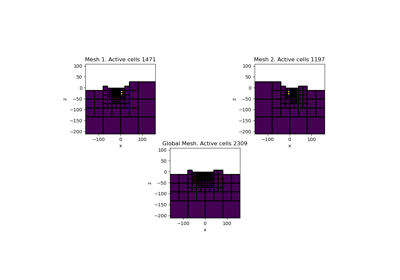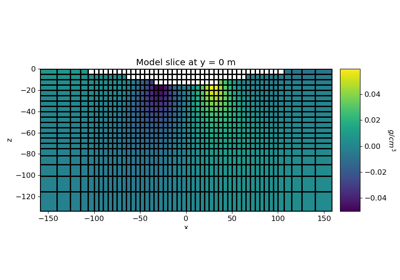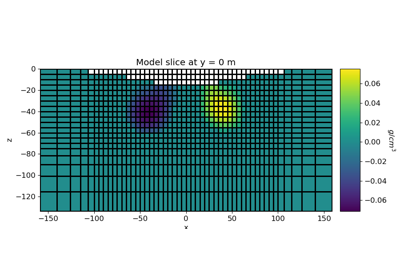simpeg.potential_fields.gravity.Simulation3DIntegral#
- class simpeg.potential_fields.gravity.Simulation3DIntegral(mesh, rho=None, rhoMap=None, engine='geoana', numba_parallel=True, **kwargs)[source]#
Bases:
BasePFSimulationGravity simulation in integral form.
Important
Density model is assumed to be in g/cc.
Important
Acceleration components (“gx”, “gy”, “gz”) are returned in mgal (\(10^{-5} m/s^2\)).
Important
Gradient components (“gxx”, “gyy”, “gzz”, “gxy”, “gxz”, “gyz”) are returned in Eotvos (\(10^{-9} s^{-2}\)).
- Parameters:
- mesh
discretize.TreeMeshordiscretize.TensorMesh Mesh use to run the gravity simulation.
- survey
simpeg.potential_fields.gravity.Survey Gravity survey with information of the receivers.
- active_cells(
n_cells)numpy.ndarray,optional Array that indicates which cells in
meshare active cells.- rho
numpy.ndarray,optional Density array for the active cells in the mesh.
- rhoMap
Mapping,optional Model mapping.
- sensitivity_dtype
numpy.dtype,optional Data type that will be used to build the sensitivity matrix.
- store_sensitivities{“ram”, “disk”, “forward_only”}
Options for storing sensitivity matrix. There are 3 options
‘ram’: sensitivities are stored in the computer’s RAM
‘disk’: sensitivities are written to a directory
‘forward_only’: you intend only do perform a forward simulation and sensitivities do not need to be stored. The sensitivity matrix
Gis never created, but it’ll be defined as aLinearOperator.
- sensitivity_path
str,optional Path to store the sensitivity matrix if
store_sensitivitiesis set to"disk". Default to “./sensitivities”.- engine{“geoana”, “choclo”},
optional Choose which engine should be used to run the forward model.
- numba_parallelbool,
optional If True, the simulation will run in parallel. If False, it will run in serial. If
engineis not"choclo"this argument will be ignored.- ind_active
np.ndarrayofintor bool Deprecated since version 0.23.0: Argument
ind_activeis deprecated in favor ofactive_cellsand will be removed in SimPEG v0.24.0.
- mesh
Attributes
Gravity forward operator.
Active cells in the mesh.
A list of solver objects to clean when the model is updated
SimPEG
Counterobject to store iterations and run-times.HasModel.deleteTheseOnModelUpdate has been deprecated.
Engine that will be used to run the simulation.
Diagonal of GtG
active_cells.ind_active has been deprecated.
The model for a linear problem physical property model.
Mesh for the integral potential field simulations.
The inversion model.
Derivative of The model for a linear problem wrt the model.
Mapping of the inversion model to The model for a linear problem.
Number of processes to use for forward modeling.
True if a model is necessary
Run simulation in parallel or single-threaded when using Numba.
Density physical property model.
Derivative of Density wrt the model.
Mapping of the inversion model to Density.
dtype of the sensitivity matrix.
Path to directory where sensitivity file is stored.
Options for storing sensitivities.
The survey for the simulation.
Verbose progress printout.
Methods
Jtvec(m, v[, f])Dot product between transposed sensitivity matrix and a vector.
Jtvec_approx(m, v[, f])Approximation of the Jacobian transpose times a vector for the model provided.
Jvec(m, v[, f])Dot product between sensitivity matrix and a vector.
Jvec_approx(m, v[, f])Approximation of the Jacobian times a vector for the model provided.
dpred([m, f])Predicted data for the model provided.
evaluate_integral(receiver_location, components)Compute the forward linear relationship between the model and the physics at a point and for all components of the survey.
fields(m)Forward model the gravity field of the mesh on the receivers in the survey
getJ(m[, f])Sensitivity matrix \(\mathbf{J}\).
getJtJdiag(m[, W, f])Compute diagonal of \(\mathbf{J}^T \mathbf{J}`\).
Return linear operator.
make_synthetic_data(m[, relative_error, ...])Make synthetic data for the model and Gaussian noise provided.
residual(m, dobs[, f])The data residual.
Galleries and Tutorials using simpeg.potential_fields.gravity.Simulation3DIntegral#

Forward Simulation of Gravity Anomaly Data on a Tensor Mesh
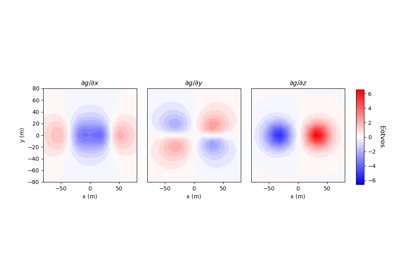
Forward Simulation of Gradiometry Data on a Tree Mesh
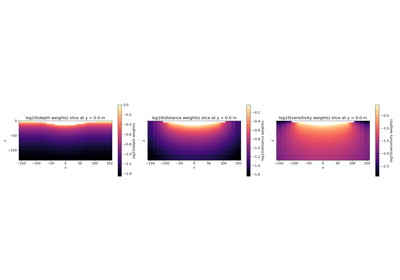
Compare weighting strategy with Inversion of surface Gravity Anomaly Data
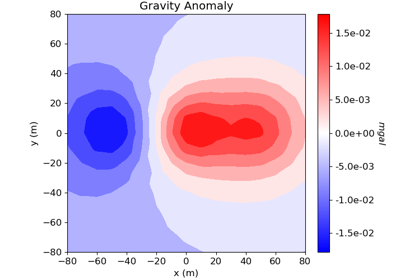
Cross-gradient Joint Inversion of Gravity and Magnetic Anomaly Data

Joint PGI of Gravity + Magnetic on an Octree mesh using full petrophysical information

Joint PGI of Gravity + Magnetic on an Octree mesh without petrophysical information

